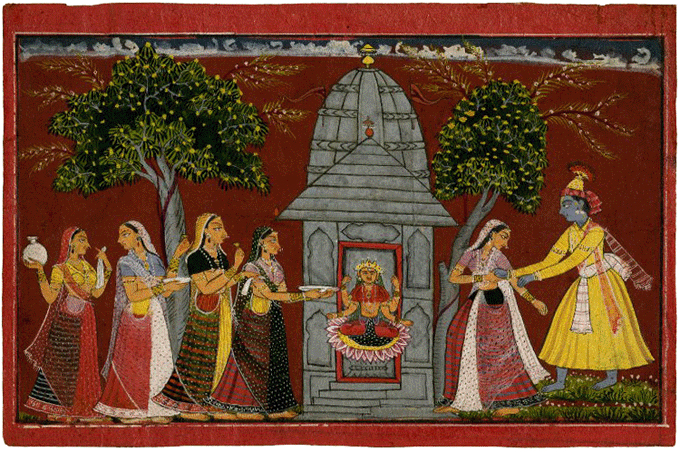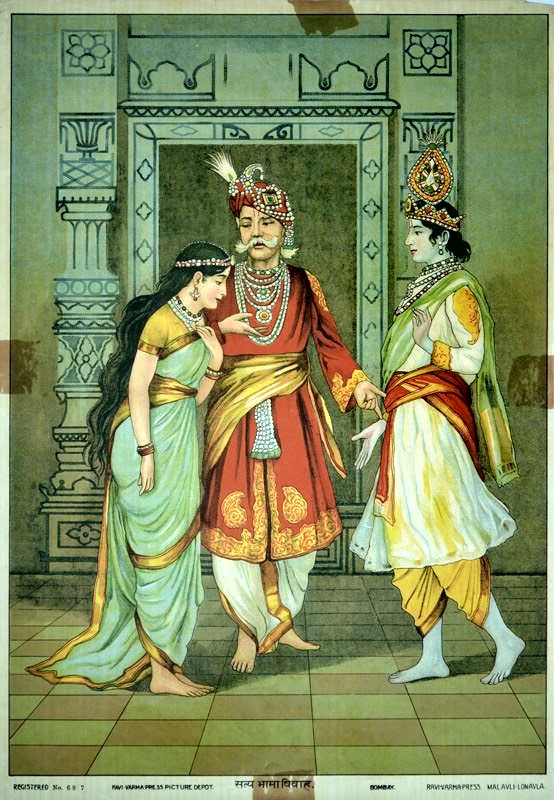|
Parijatapaharanamu
''Parijatapaharanamu'' (parijata+apaharanamu) (lit. the purloining of the Parijata tree) is a Telugu poem composed by Nandi Thimmana. It is based on a story from '' Harivamsam''. The story is about love quarrel between Krishna and his consorts Rukmini and Satyabhama. Plot Narada brings a parijatam, a flower that has everlasting fragrance, from Indra's tree to Krishna. Krishna is at Rukmini's house at the time, so he gives the flower to her. Satyabhama learns that he gave the flower to Rukmini, and becomes jealous. Krishna fights the devatas for the tree, and brings the tree back to Satyabhama. Publications * Parijatapaharamu was published by Andhra Patrika press in 1929. It also included a detailed commentary named Parimalollasamu by Nagapudi Kuppuswamy. * In 1933 Vavilla Ramaswamy Sastrulu and Sons along with Surabhi commentary. It was again reprinted in 1960. Dusi Ramamurthi Sastry wrote a detained preface to both editions. * Andhra Pradesh Sahitya Akademi 1978 printed it fo ... [...More Info...] [...Related Items...] OR: [Wikipedia] [Google] [Baidu] |
Nyctanthes Arbor-tristis
''Nyctanthes arbor-tristis'' is a species of '' Nyctanthes'' native to South Asia and Southeast Asia.Flora of Pakistan''Nyctanthes arbor-tristis''/ref>AgroForestry Tree Database''Nyctanthes arbor-tristis'' It is commonly known as night-blooming jasmine, tree of sadness, tree of sorrow, hengra bubar, coral jasmine, as seri gading in Singapore and as shiuli in the Bengal region. Despite its common name, the species is not a "true jasmine" and not of the genus Jasminum. Names The tree is called the "tree of sorrow" because the foliage becomes droopy as blooming flowers fall off during early morning. The Latin specific epithet ''arbor-tristis'' means "sad tree". In India and Nepal, ''Nyctanthes arbor-tristis'' is known as pārijāta (पारिजात). In other Indian languages, it is known as ''harsinghar'' (Hindi), ''sephalika'' (Sanskrit), ''shiuli/shephali'' ( Bengali), ''pavalamallikai'' (Tamil), ''prajakta'' (Marathi), ''parijaata'' (Kannada), ''pavizhamalli'' (Malaya ... [...More Info...] [...Related Items...] OR: [Wikipedia] [Google] [Baidu] |
Nandi Thimmana
Mahakavi Nandi Thimmana ( Telugu: నంది తిమ్మన; c. 15th and 16th centuries CE) was a Telugu poet and an Ashtadiggaja in the imperial court of Emperor Krishnadevaraya of Vijayanagara. He is often called Mukku Thimmana () after his celebrated poem on a woman's nose. Biography Thimmana is believed to be from Anantapur and was born to Singanna and Thimmamaamba. He lived in a subkingdom of the Vijayanagara Empire, whose princess was Tirumala Devi. Later tradition imagines Nandi Timmana as one of the so-called asta-dig-gajas, the eight elephants of the cardinal directions, who supposedly graced the court of Krsnadevarāya at the apogee of the Vijayanagara period. Although this set of eight is probably a later (seventeenth-century) invention, Timmana's presence at Krsnadevarāya's court is historically verified. The poet dedicated his work, Pārijātâpaharanamu, to this king. The tradition asserts that the poet arrived in the court as a gift from the family of ... [...More Info...] [...Related Items...] OR: [Wikipedia] [Google] [Baidu] |
Vavilla Ramaswamy Sastrulu And Sons
Vavilla Ramaswamy Sastrulu and Sons ( Telugu: వావిళ్ల రామస్వామి శాస్త్రులు అండ్ సన్స్) is a 150-year-old Indian publishing house. It was started by Vavilla Ramaswamy Sastrulu in 1854 in Chennai in a press named Hindu Bhasha Sanjeevini. Later he established Adi Saraswathi Nilayam. During his lifetime, he published about 50 important books in Telugu and Sanskrit. His well-educated son Vavilla Venkateswara Sastrulu led the house in 1906 and actively continued the tradition and improved it greatly. He named it "Vavilla Press". It was associated with Gita Press of Gorakhpur and Choukhamba Press of Varanasi. He published books with perfect proofreading by the experts in the field and successfully printed in Royal, Demy and Crown sizes. He was the first to get his books bound with calico cover and glittering letters. Vavilla Press published mostly classic literature, epics, Puranas, and commentaries. They publishe ... [...More Info...] [...Related Items...] OR: [Wikipedia] [Google] [Baidu] |
Murty Classical Library Of India
The Murty Classical Library of India began publishing classics of Indian literature in January 2015. The books, which are in dual-language format with the original language and English facing, are published by Harvard University Press. The library was established through a $5.2 million gift from Rohan Murty, the son of Infosys co-founder N. R. Narayana Murthy and social worker and author Sudha Murty. The series will include translations from Bengali language, Bengali, Gujarati language, Gujarati, Hindi, Kannada, Marathi, Punjabi, Sanskrit, Tamil, Telugu, Urdu, other Indian languages and Persian. It will include fiction, poetry, nonfiction, and religious texts from all Indian traditions including Buddhism and Islam. The projected 500 volumes, to be published over a century, have a corpus of thousands of volumes of classic Indian literature to draw on. Until 2022, Sheldon Pollock served as the general editor of the library. Pollock had previously edited the Clay Sanskrit Library. ... [...More Info...] [...Related Items...] OR: [Wikipedia] [Google] [Baidu] |
Krishna
Krishna (; Sanskrit language, Sanskrit: कृष्ण, ) is a major deity in Hinduism. He is worshipped as the eighth avatar of Vishnu and also as the Supreme God (Hinduism), Supreme God in his own right. He is the god of protection, compassion, tenderness, and love; and is widely revered among Hindu divinities. Krishna's birthday is celebrated every year by Hindus on Krishna Janmashtami according to the lunisolar calendar, lunisolar Hindu calendar, which falls in late August or early September of the Gregorian calendar. The anecdotes and narratives of Krishna's life are generally titled as ''Krishna Līlā''. He is a central figure in the ''Mahabharata'', the ''Bhagavata Purana'', the ''Brahma Vaivarta Purana,'' and the ''Bhagavad Gita'', and is mentioned in many Hindu philosophy, Hindu philosophical, Hindu theology, theological, and Hindu mythology, mythological texts. They portray him in various perspectives: as a god-child, a prankster, a model lover, a divine hero, ... [...More Info...] [...Related Items...] OR: [Wikipedia] [Google] [Baidu] |
Rukmini
Rukmini (, ) is a Devi, Hindu goddess and the first queen of Krishna. She is described as the chief of Krishna's wives in Dvārakā. Rukmini is revered as the avatar of Lakshmi and is venerated primarily in Warkari, and Haridasa tradition, and additionally in Sri Vaishnavism. Rukmini is mainly worshipped in Maharashtra and South India. The people of Maharashtra venerate her with Vithoba (a regional form of Krishna) and call her Rakhumai. In South India, she is worshipped along with Krishna and his and his other primary consort Satyabhama. Her birthday is celebrated every year on the occasion of Rukmini Ashtami. Etymology and epithets The name ''Rukmini'' is derived from the Sanskrit word ''Rukma'' which means 'radiant', 'clear' or 'bright'. The name can also mean 'decorated with gold ornaments'. Other names and epithets include: *''Shri'' – Lakshmi *''Vaidarbhi'' – She who is from the kingdom of Vidarbha *''Bhaishmi'' – Daughter of Bhishmaka *''Rakhumai'' – Mother Rukm ... [...More Info...] [...Related Items...] OR: [Wikipedia] [Google] [Baidu] |
Satyabhama
Satyabhama (IAST'': Satyabhāmā)'' , also known as Satrajiti, is a Hindu goddess and the third queen consort of the Hindu god Krishna. Satyabhama is described as an incarnation of Bhumi, an aspect of Lakshmi. She is the goddess and the personification of the Earth. She has two sisters named Vratini and Prasvapini who are her co-wives as well. According to some traditions, she is regarded to have aided Krishna in defeating the asura Narakasura. Legend Marriage to Krishna Satyabhama was the daughter of Yadava King Satrajita, the royal treasurer of Dvaraka, who was the owner of the Syamantaka jewel. Satrajita, who secured the jewel from the sun-god Surya and would not part with it even when Krishna, the king of Dvaraka, asked for it saying it would be safe with him. Shortly thereafter, Prasena, the brother of Satrajita, went out hunting wearing the jewel but was killed by a lion. Jambavan, known for his role in the Ramayana, killed the lion and gave the jewel to his ... [...More Info...] [...Related Items...] OR: [Wikipedia] [Google] [Baidu] |
Narada
Narada (, ), or Narada Muni, is a sage-divinity, famous in Hinduism, Hindu traditions as a travelling musician and storyteller, who carries news and enlightening wisdom. He is one of the Manasputra, mind-created children of Brahma, the creator god. He appears in a number of Hindu texts, notably the Mahabharata, telling Yudhishthira the story of Prahlada, Prahalada, and he also appears in the Ramayana and the Puranas. A common theme in Vaishnavism is the accompaniment of a number of deities such as Narada to offer aid to Vishnu upon his descent to earth to combat the forces of evil, or to enjoy a close view of epochal events. He is also referred to as ''Rishiraja'', meaning the king of all sages. He was gifted with the boon of knowledge regarding the past, present, and the future. Hinduism In Indian texts, Narada travels to distant worlds and realms (Sanskrit: ''lokas''). He is depicted carrying a khartal (musical instrument) and the veena, and is generally regarded as one of ... [...More Info...] [...Related Items...] OR: [Wikipedia] [Google] [Baidu] |
Indra
Indra (; ) is the Hindu god of weather, considered the king of the Deva (Hinduism), Devas and Svarga in Hinduism. He is associated with the sky, lightning, weather, thunder, storms, rains, river flows, and war. [3 volumes] Indra is the most frequently mentioned deity in the ''Rigveda''. He is celebrated for his powers based on his status as a god of order, and as the one who killed the great evil, an Asura (Hinduism), asura named Vritra, who obstructed human prosperity and happiness. Indra destroys Vritra and his "deceiving forces", and thereby brings rain and sunshine as the saviour of mankind. Indra's significance diminishes in the post-Vedic Indian literature, but he still plays an important role in various mythological events. He is depicted as a powerful hero. According to the ''Vishnu Purana'', Indra is the title borne by the king of the gods, which changes every Manvantara – a cyclic period of time in Hindu cosmology. Each Manvantara has its own Indra and the In ... [...More Info...] [...Related Items...] OR: [Wikipedia] [Google] [Baidu] |
Devata
''Devata'' (pl: ''devatas'', meaning 'the gods') are smaller and more focused Devas (Deities) in Indian religions, such as Hinduism and Buddhism. The term "devata" itself can also mean deva. They can be either male or female. Every human activity has its devata, its spiritual counterpart or aspect. Types There are many kinds of devatas: vanadevatas (forest spirits, perhaps descendants of early nature-spirit cults), gramadevata (village gods), devatas of river crossings, caves, mountains, and so on. For example, in the Konkan region of India, Hindu devatas are often divided into five categories: # Gramadevata, Grama devatas or village deities who could be the founder deity such as Punjabi folk religion#Jathera—ancestral shrines, Jathera or Balinese Hinduism#Rituals, ancestral worship of Bali, and examples include Santoshi, Renuka, Aiyanar # Sthana devatas or local deities, for example, those in certain places of pilgrimage like Rama in Nasik, Vithoba in Pandharpur, Krishn ... [...More Info...] [...Related Items...] OR: [Wikipedia] [Google] [Baidu] |
Andhra Patrika
''Andhra Patrika'' was an Indian Telugu-language newspaper founded by Kasinathuni Nageswara Rao on 9 September 1908. It was initially a weekly publication and later transformed into a daily newspaper. It played an influential role in India’s nationalist movement. The newspaper had a lasting impact on the development of modern Telugu language and was instrumental in shaping the cultural and political identity that contributed to the creation of Andhra Pradesh. ''Andhra Patrika'' continued publication until it closed in 1991. History Kasinathuni Nageswara Rao founded the weekly as he recognized the need for a Telugu language journal to campaign effectively for the Indian freedom struggle and founded the weekly, and the newspaper wandered all over the territories in which the Telugu language was spoken. Rao moved the newspaper to Madras in 1914 to get closer to Telugus, and after a few years turned it into the first enduring daily in Telugu. Gaining a reputation even among t ... [...More Info...] [...Related Items...] OR: [Wikipedia] [Google] [Baidu] |



